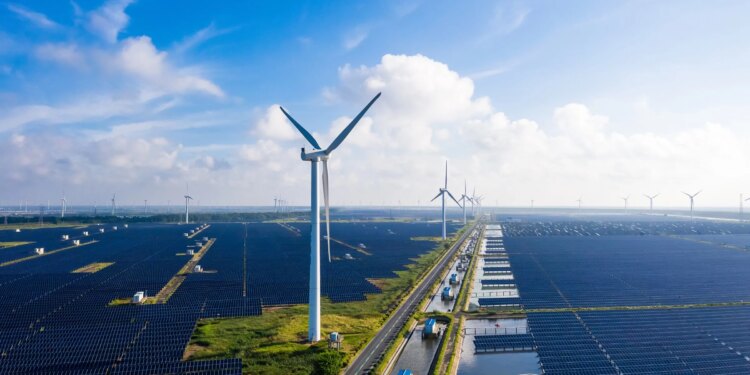[ad_1]
In a warming world, the transition from fossil fuels to renewable energy is heating up. International capability for renewable energy era is increasing extra rapidly than at any time within the final thirty years, in line with the Worldwide Power Company (IEA). The agency predicts that by 2025, renewable vitality will surpass coal to grow to be the world’s high supply of electrical energy. Wind and photo voltaic photovoltaic (PV) energy era are forecast to exceed nuclear energy era in 2025 and 2026, respectively. And by 2028, 68 countries will boast renewables as their important supply of energy.
The acceleration in clear, renewable vitality energy era comes not a second too quickly for policymakers and advocates involved with climate change attributable to greenhouse gas emissions.
Insurance policies driving growth
At 2023’s United Nation’s Local weather Change Convention (COP28), governments set a purpose to triple world renewables energy capability by 2030. This may ideally assist advance decarbonization, mitigate local weather change and obtain net-zero emissions, according to the IEA.
To develop renewable vitality expertise, governments are turning to numerous public coverage measures. The European Union’s Inexperienced Deal Industrial Plan, India’s Manufacturing Linked Incentives (PLI) and the Inflation Discount Act (IRA) within the US are all insurance policies designed to additional stimulate the combination of sustainable vitality. Supportive financial insurance policies in China have accelerated onshore wind and photo voltaic photovoltaic vitality tasks there, serving to the nation surpass nationwide 2030 targets years forward of schedule. (That is essential to the purpose of tripling worldwide renewables as China accounts for nearly 60% of all new world renewable vitality capability expected to come online by 2028.) As well as, evolving rules on company environmental, social and governance (ESG) initiatives all over the world are growing demand for renewable vitality within the non-public sector, encouraging additional development.
Renewable vitality development by sort
Broad coverage measures however, coverage assist usually varies relying on the kind of renewable vitality in query. Let’s take a better have a look at a number of sorts of renewable vitality sources and the traits taking form in every class.
Solar energy
In 2023, photo voltaic photovoltaic vitality made up three-quarters of renewable capability additions all over the world, in line with the IEA. Capability development stemmed from each utility-scale vegetation and client adoption of distributed PV techniques—on-site solar energy era at houses and companies—accounted for the other half.
Continued coverage assist from governments all over the world stays the first driver of this development. For instance, some policymakers incentivize renewable energy era by people and companies via net-metering packages that permit utility prospects to ship extra vitality generated again to their utilities for credit. Different incentives encouraging the manufacturing and use of solar energy embody feed-in-tariffs, tax credit and auctions through which solar energy suppliers compete on vitality market worth to win contracts.
The enlargement of the photo voltaic PV provide chain is enabling the manufacturing obligatory to satisfy the calls for of the rising trade. Extra manufacturing capability within the US, India and the EU is predicted to assist diversify the photo voltaic PV provide chain, however China continues to dominate the area. (The nation was residence to 95% of new solar technology manufacturing facilities in 2022.) And developments in photo voltaic photovoltaic expertise are producing lighter, less expensive, more efficient solar panels that may proceed to extend era capability over time.
Primarily based on the IEA’s Web Zero Emissions by 2050 Situation (NZE), if present development charges are maintained via 2030, photo voltaic PV is “on observe” to satisfy annual era capability of roughly 8,300 terawatt hours (TWh) by the end of the decade. As well as, photo voltaic PV is predicted to be the dominant supply of vitality within the manufacturing of low-emissions or inexperienced hydrogen. Low-emissions hydrogen (in distinction to hydrogen produced with fossil gas energy) can probably drive greater decarbonization efforts in companies starting from steelmaking to ammonia manufacturing, the place hydrogen is used for industrial functions.
Wind energy
As with solar energy, public insurance policies have been key to driving wind vitality enlargement, however development projections differ by area. China noticed a 66% improve in wind energy capability in 2023 and is on observe for extra additions within the coming years. Mission growth, nevertheless, has been slower than initially anticipated in Europe and North America. Offshore wind tasks have been particularly weak: In 2023, within the US and UK alone, builders canceled offshore projects with complete capability of 15 gigawatts (GW).
Latest public insurance policies might assist assist the trade throughout this difficult interval. In 2023, the European Union introduced its Wind Energy Motion Plan, with measures to enhance allowing, public sale processes and financing entry in addition to expand workforce training. In the identical yr, 9 European nations introduced plans to extend offshore wind energy capability to over 120 GW by 2030 and over 300 GW by 2050. In the meantime, within the US, the federal government is investing within the growth of floating wind farms. The deployment of floating wind farms with a capability of 15 GW is expected by 2035.
For wind energy to satisfy the targets of the IEA’s NZE, common annual development would wish to reach or surpass 17% per year until 2030.
Hydropower
At present, hydropower generates extra energy—reaching 4,300 TWh in 2022— than all different clear vitality sources mixed and can stay the biggest supply via 2030, in line with the IEA. Regardless of small however regular development and confirmed reliability, new hydropower additions are forecast to decrease 23% over the subsequent decade as a result of growth slowdowns in Europe, China and Latin America.
Over the previous 20 years, vitality trade focus has shifted from hydropower, with most nations focusing insurance policies and incentives on increasing photo voltaic and wind energy. Right this moment, less than 30 countries supply insurance policies to assist new hydropower growth and refurbishment of present vegetation versus over 100 nations with insurance policies to assist wind and photo voltaic PV.
To satisfy the NZE Situation, hydropower would wish to develop at an annual price of at least 4%.
Biofuel
International biofuel enlargement is underway, thanks largely to supportive authorities insurance policies in rising economies reminiscent of Brazil, India and Indonesia. Demand is essentially pushed by the transportation sector in these nations, whereas provide is enabled by the provision of biomass feedstock. Brazil leads the way in which in biofuel enlargement, accounting for a projected 40% of growth by 2028.
Biofuel enlargement is extra restricted within the EU, US, Canada and Japan due partly to excessive prices and the rising reputation of electrical autos. The primary areas of development for biofuels in these nations are the renewable diesel and biojet gas segments. General, biofuels reminiscent of bioethanol and biodiesel, together with electrical autos (EVs), have the potential to offset the oil equal of 4 million barrels by 2028. Such milestones however, the IEA predicts that biofuel enlargement will nonetheless fall wanting 2030 NZE targets.
Biogas: Whereas the expansion of the biogas trade started within the Nineties, the final two years have seen a rise in coverage assist for the pure fuel different. At present, virtually half of all world biogas manufacturing comes from Europe, with 20% of that from Germany alone.
Traditionally, biogas has been used at warmth and energy vegetation. Extra not too long ago, nevertheless, governments have inspired industrial and transportation makes use of for biomethane, a biogas which, as its title suggests, comprises a considerable focus of methane. With 13 nations implementing robust new insurance policies supporting biogas since 2022, the IEA projects that biogas manufacturing development will speed up via 2028.
Geothermal vitality
Technological developments are creating alternatives to convey geothermal vitality to extra locations. For instance, via Enhanced Geothermal Power Techniques, fluid is injected underground in areas with out naturally occurring scorching water sources. The fluid heats up underground after which is pumped to the floor, where it generates electricity. Numerous geothermal tasks are deliberate or underway across the phrase, together with in North America, Europe and Asia.
Such developments however, advocates for geothermal vitality say insurance policies are wanted to benefit from its untapped potential. The capital-intensive nature and financing prices of geothermal tasks may be prohibitive. The evolution of economies of scale and continued technological developments might assist drive down prices, however for now, the IEA forecasts that solely about 1% of renewable vitality shall be sourced from geothermal vitality manufacturing by 2030.23
Know-how to assist evolving renewable vitality
As extra renewable vitality is added to vitality techniques, expertise will play a vital function in conserving the vitality provide flowing whereas making certain vitality safety and the soundness of energy grids.
As a result of renewable vitality sources, particularly wind and photo voltaic, are weak to environmental situations, making certain optimum manufacturing and distribution is essential to offering a secure, resilient energy provide. Renewables forecasting is quickly changing into an necessary software within the vitality transition. For instance, options such because the IBM Renewables Forecasting Platform throughout the IBM Environmental Intelligence Suite can present day-ahead wind and solar forecasts with 92% accuracy.
Higher storage may even assist make energy techniques extra resilient. Photo voltaic, wind and hydropower all require vitality storage techniques (ESS) to offer a constant vitality provide. As grid-scale battery expertise evolves, utility corporations will be capable of retailer electrical energy long-term to higher handle load during times of low- or non-production. As an example, circulate batteries are a low-cost and scalable type of long-term grid-scale vitality storage presently being developed.
From batteries to photo voltaic arrays, efficient asset administration is a crucial element in supporting a clear vitality transition; clever asset administration and predictive upkeep can monitor asset well being and delay its lifespan. As an example, the New York Energy Authority (NYPA) is streamlining its asset administration with the IBM Maximo® Application Suite. The purpose is to digitalize the state’s energy infrastructure and remodel it right into a clear, dependable, resilient and reasonably priced system over the subsequent decade.
Increase your sustainability journey and take advantage of your vitality investments by connecting your strategic roadmap with day-to-day operations.
Discover the IBM Environmental Intelligence Suite for Energy and Utilities and see the IBM Maximo Application Suite for Energy and Utilities.
Get started with ESG and your sustainability journey
Was this text useful?
SureNo
[ad_2]
Source link


